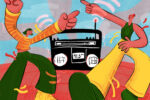Last week I woke up with lyrics pulsing through my head: “I won’t run away no more / I promise / Even when I get bored / I promise / Even when you lock me out / I promise / Say my prayers every night / I promise.” The mantra-like structure of the “OK Computer”-era Radiohead B-side — predictably titled “I Promise” — lent itself to stickiness, and that morning it was stuck harder than I could have ever imagined in my ears and brain. I made breakfast, went to online summer school, ate lunch and went for a bike ride humming that chorus over and over again: “I promise… I promise… I promise.”
At first, the sensation was endearing. I alternated between humming and singing as I went about my day, relishing the experience of having a lovely song perfectly reimagined in my head. Quickly, however, I began to tire of it. The constant reiteration of a snippet of melody grated on my ears, and only after several full listens of the whole song did it get out of my head. Like many other quirks of the human brain, the earworm phenomenon, or “involuntary musical imagery” as it is referred to scientifically, has been studied to a surprising extent. Recent research suggests that features of a song as simple as a catchy hook and frequent radio play can hugely increase the likelihood of getting it stuck in your head.
As a longtime fan of relatively obscure indie music, I pride myself on never being up to date with the standard fare of radio pop. Hearing a song, being told it is immensely popular, then promptly (and honestly) replying that I’ve never heard it before feeds my musical superiority complex like nothing else. Somehow, still, I cannot go a week without an immensely popular tune getting stuck in my head. According to an article titled “Dissecting an Earworm,” this may be directly related to the fact that the popularity of a song is a significant factor in whether or not it becomes an earworm.
Pop songs that feature more standard or common melodic traits, which are known by producers to be catchy and pleasant to the ears, are far more likely to end up being earworms than other less common riffs. Songs such as “Don’t Stop Believing,” “Bad Romance” or “Old Town Road” fit this perfectly; the first two are proven earworms, and the latter’s chart success suggests that it was a modern case of a pop song becoming a subconsciously infectious tune. This makes sense, but what may come as a surprise is the timing and frequency of these phantom songs, as well as the number of people who report experiencing them.
Spread nearly evenly between genders, around 10% of people report having an earworm less than once a week. A third contract them weekly, another third daily, and 25% of people experience earworms multiple times a day. There is something reassuring about this. Most people are unconcerned when I say I have a song stuck in my head and some are quick to advise me to listen to the song to get it out. Still, sometimes I wonder: Is the fact that I’ve been dancing to music in my head for an hour at work crazy? According to this research, it’s not.
Although we know a relatively tiny amount of what there is to understand about the human brain, the huge recurrence of these auditory hallucinations seems indicative of something within the human mind. While visual hallucinations are well-known touchpoints for expressions of insanity or intoxication, these musical images are an almost universal part of the human experience.
We all know what it is like to have a song stuck in our heads, whether it is a chorus, a bar or a whole passage of melody. We all understand the feeling of being tied against our will, for better or worse, to music. This seems linked to a lack of constant musical stimulation, as opposed to constant stimulation of other senses. At any moment, even with eyes closed, we are given visual stimulation by light playing over our eyelids. At all times our sense of smell is triggered by our surroundings, and our sense of touch is stimulated by anything from clothing to the wind. Although we are constantly auditorily triggered as well, in the absence of a pattern-based sound to latch onto, it makes sense that we latch onto past experiences with sounds that are well known to us. In a world of constant stimulation, a lack of it seems to lead to imagined stimulation.
Even if there may be a more exciting explanation for the preponderance of earworms, in the end, the clearest and most common factors behind this phenomenon are the popularity of a song, melodic recognizability and memories. Whether from a memory triggered by a musical cue or a radio station blasting intentionally designed catchy pop tunes, earworms are literally impossible to avoid. Rather than attempt to reduce the frequency of these occurrences, one may be better served by building a repertoire of techniques to stop them in their tracks. Some recommend listening to another song to kick the earworm out of your head, but this runs the risk of simply replacing the first tune. Other popular techniques include chewing gum or distracting oneself with a brain teaser or puzzle.
In the end, the earworm is a phenomenon that can range from intriguing to entertaining, enjoyable to infuriating, even from baffling to expected. Although studies have been conducted to demonstrate the links between popularity, memory, rhythm and melody in making a song more or less likely to be stuck in a listener’s head, these realizations feel somewhat banal. Of course these are important factors, but as I write this, I wonder: Why is a relatively obscure song that I haven’t heard in years stuck in my head right now? Research can find trends in earworms, but as with many other brain processes, science is far from fully understanding the core reasoning behind this facet of life.
With lyrics still ringing through my ears, I am left with two options: Continue down the rabbit hole of research, or let the mystery be; sometimes, when it comes to the ways my mind fidgets, I prefer to choose the latter.

















